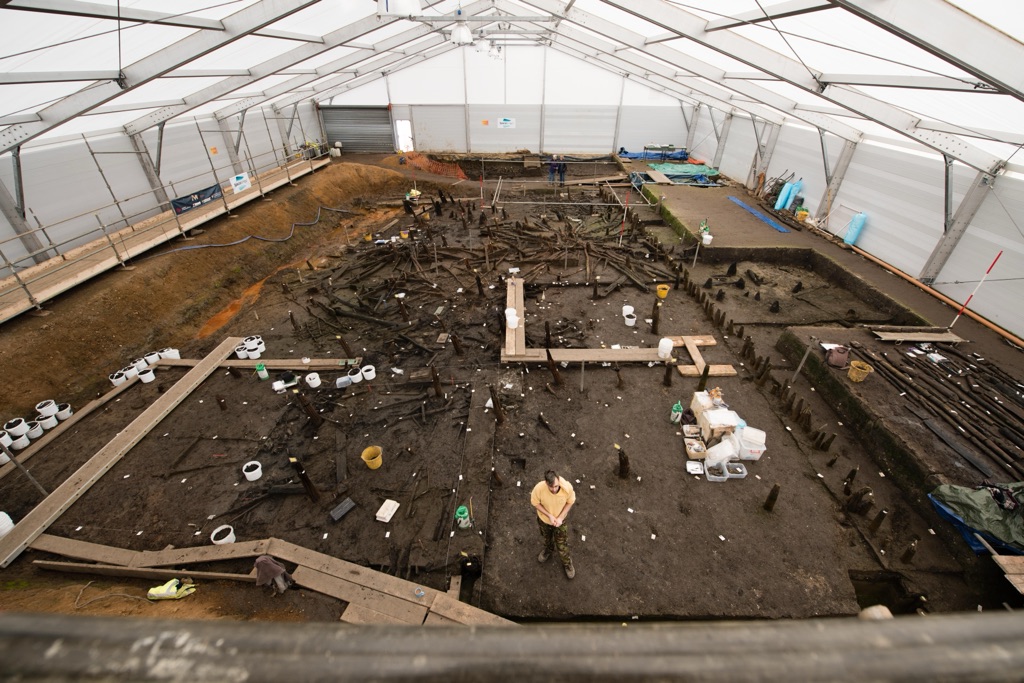Must Farm is an archaeological site near Peterborough, in Cambridgeshire, England. It has been dubbed “Britain’s Pompeii” due to the remarkable preservation of Bronze Age dwellings. Discovered in 2006 during routine quarrying, the site has since revealed a wealth of information about domestic life 3,000 years ago. Excavations have uncovered wooden roundhouses, complete with their contents, offering a snapshot of a moment frozen in time, likely due to a catastrophic fire.
Get your dose of History via Email
Historical Background of Must Farm
Must Farm’s discovery in 2006 was a stroke of luck. Quarrying operations at a clay pit near Whittlesey unearthed the site, prompting a full-scale excavation. The Cambridge Archaeological Unit led the dig, revealing a Bronze Age settlement that had collapsed into a river channel. This wet environment preserved the wooden structures and a trove of artifacts. The site dates back to about 1000-800 BC, a time when the Bronze Age was transitioning to the Iron Age.
The builders of Must Farm were skilled craftspeople, as evidenced by the complex wooden structures. They constructed their homes on stilts above a river, which suggests a deep understanding of their environment. The settlement’s design was both practical and sophisticated, catering to the needs of its inhabitants. The site’s preservation allows us to glimpse the daily lives of these ancient people.
Over time, Must Farm attracted various inhabitants. However, the dwellings we see today were likely occupied for a short period. A dramatic fire caused the stilted roundhouses to collapse into the river, which quickly extinguished the flames and preserved the remains. This event has provided historians and archaeologists with a unique snapshot of Bronze Age life.
Must Farm is not known to have been the scene of any historically significant events. Instead, its significance lies in the everyday details it reveals. The site offers insights into the domestic life, diet, and technology of the time. It is a window into a past that is often overshadowed by grand historical narratives.
The discovery of Must Farm has not only shed light on the Bronze Age but also on the methods of modern archaeology. The careful excavation and analysis of the site have set a new standard for archaeological practice. It demonstrates the potential for even small-scale settlements to transform our understanding of history.
About Must Farm
Must Farm’s archaeological site is a treasure trove of Bronze Age life. The site consists of several roundhouses, built on timber stilts above a river. These structures were made from local wood, with walls of wattle and daub and roofs likely thatched with reeds. The roundhouses contained everyday objects, from pottery to textiles, preserved in astonishing detail.
The construction methods at Must Farm were advanced for their time. The wooden stilts were driven deep into the riverbed, creating a stable foundation for the roundhouses. This technique suggests a sophisticated understanding of engineering and carpentry. The choice of materials reflects a close relationship with the surrounding environment.
Inside the roundhouses, archaeologists found an array of artifacts. These include tools, weapons, and personal items such as clothing and jewelry. The presence of these items provides a vivid picture of the daily activities and social practices of the inhabitants. The quality of the artifacts indicates a community with skilled artisans.
The architectural highlights of Must Farm include the well-preserved roundhouses themselves. Their circular design was common during the Bronze Age, but rarely are they found in such a complete state. The site also features a wooden palisade that may have served as a defensive structure or boundary marker.
The materials used at Must Farm were predominantly organic, which typically do not survive long periods. However, the anaerobic conditions of the riverbed prevented the decay of these materials. This exceptional preservation provides an unparalleled look at the architecture and material culture of the Bronze Age.
Theories and Interpretations
Theories about Must Farm revolve around its use and the sudden abandonment. Some suggest the settlement was a temporary site, perhaps seasonal, due to the short period it was inhabited. Others propose that it was a more permanent settlement that met an untimely end due to the fire.
The cause of the fire at Must Farm is a mystery. While some speculate it was accidental, others theorize it could have been an attack by rival groups. The fire’s intensity suggests it spread quickly, leaving little time for the inhabitants to salvage their belongings.
Interpretations of the site have had to rely on the artifacts and their context. The objects found within the roundhouses suggest a range of domestic activities, from cooking and food storage to weaving and tool-making. These interpretations match historical records of Bronze Age communities in the region.
Dating of Must Farm has been carried out using dendrochronology and radiocarbon methods. These techniques have confirmed the settlement’s age, placing it firmly in the late Bronze Age. The precision of the dating has helped to align the site with broader historical timelines.
Must Farm continues to be a subject of study, with new theories emerging as research progresses. The site challenges our understanding of Bronze Age life, offering a narrative that is both complex and compelling. It is a testament to the interpretative power of archaeology.
At a glance
Country: England
Civilization: Bronze Age Britain
Age: Approximately 3,000 years old (1000-800 BC)
Conclusion and Sources
The information in this article has been obtained from the following reputable sources:

